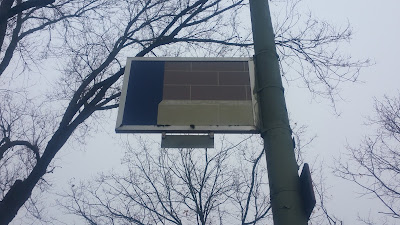 |
| Berlin, Germany. Image of the former Münchener Straße 37 on view in the Bayerischer Platz U-Bahn station. Photo: Samuel D. Gruber 2016 |
by Samuel D. Gruber
In November 2016, I was in Berlin for a few days and had the chance to visit more Jewish and Holocaust-related historical and commemorative sites than usual. I've already posted about the Jewish cemetery on Grosse Hamburger Strasse and the monument and burial section at the Weissensee Cemetery for Jewish soldiers who died in World War I. Here's information on a lesser known commemorative site.
The domed synagogue at Münchener Straße 37 in the Schöneberg section of Berlin, designed by Jewish architect Max Fraenkel (1856-1926), was dedicated in 1910 and was at the center of a heavily Jewish neighborhood around Bayerischer Platz. It was looted but not burned on Kristallnacht (November 9, 1938), but was subsequently damaged by aerial bombing during the war years, and torn down in 1956. The synagogue, which was a transitional structure between historicism and modernism, was notable for its large dome, and as one of the more architecturally distinctive buildings in the largely residential neighborhood. The composer Kurt Weill had a job as the synagogue choir conductor for a few months in 1921.
Today, there is a part of a school building on the synagogue site, but the synagogue is remembered in the neighborhood in various ways. Each memorial corresponds to a particular phase of Berlin's facing the past and acknowledge the Shoah. There is an official abstract street level monument (1960s), a student-built collaborative memorial (1990s) and recently an extensive photo exhibit underground in the nearby U-Bahn station.
At the school, the original synagogue outline is remembered through garden design and in 1994-95 students erected a memorial brick wall on the school grounds to remember local Jews who lived in Berlin-Schöneberg. According to school officials,"the idea was based on the artist Horst Hoheisel from Kassel who gave stimulus on his "memorial from down below" in the framework of the 6th grade teaching lesson "National Socialism".
 |
| Berlin, Germany. Löcknitz Primary School on site of the synagogue at Münchener Straße 37. Photo: Samuel D. Gruber 2016. |
 |
| Berlin, Germany. Monument to destroyed at synagogue at Münchener Straße 37. Gerson Fehrenbach, arch., 1963. Photo: Samuel D. Gruber 2016. |
 |
| Berlin, Germany. Monument to destroyed at synagogue at Münchener Straße 37. Photo: Samuel D. Gruber 2016. |
A plaque beneath gives further information about the fate of the building.
Hier stand von 1909-1956 eine Synagoge. Sie wurde während der Reichspogromnacht
am 9. Nov. 1938 wegen ihrer Lage in einem
Wohnhaus nicht zerstört.
Nach der Vertreibung und Vernichtung
der jüdischen Mitbürgerinnen und Mitbürger
durch die Nationalsozialisten verlor sie
ihre Funktion und wurde 1956 abgerissen.”
In the nearby U-Bahn station there is a extensive photo exhibition on the history of the neighborhood. Since it was a heavily Jewish district in the interwar period, there is are many images of the synagogue and of prominent Jews who lived nearby. When I visited the station in November 2016, the former synagogue - already destroyed once - was suffering the indignity of having a temporary construction barrier interrupting the view of its full facade.
Bayerischer Platz neighborhood, including Münchener Straße, is also the location of the noteworthy "Places of Remembrance," (Orte des Erinnerns) project designed by artists Renata Stih and Frieder Schnock and installed in 1993. The memorial, which consists of 80 signs which flatly state the dates and essence of laws promulgated by the Nazis in the 1930s to curb the rights of Jews. This project remains one of the most thought provoking Holocaust commemorative installations anywhere - if one takes the time to look.
 |
| Berlin, Germany. Bayerischer Platz and "Places of Remembrance," (Orte des Erinnerns) project designed by Renata Stih and Frieder Schnock. Photo: Samuel D. Gruber 2016. |
 |
| ABerlin, Germany. Bayerischer Platz and "Places of Remembrance," (Orte des Erinnerns) project designed by Renata Stih and Frieder Schnock. Photo: Samuel D. Gruber 2016. |
 |
| Berlin, Germany. Bayerischer Platz and "Places of Remembrance," (Orte des Erinnerns) project designed by Renata Stih and Frieder Schnock. Photo: Samuel D. Gruber 2016. |






No comments:
Post a Comment